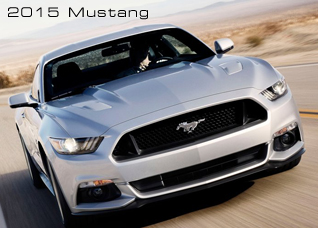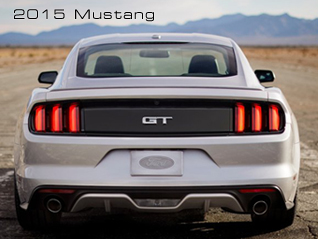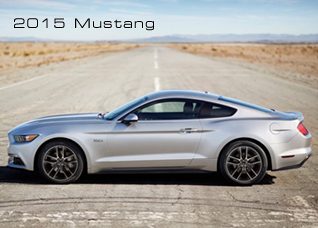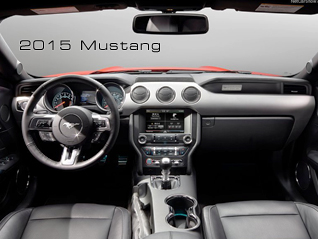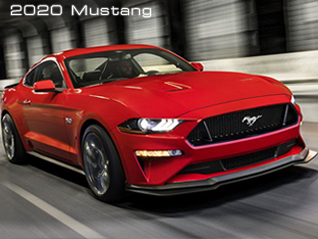
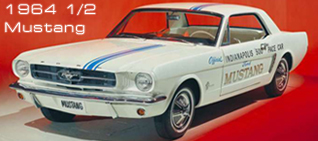
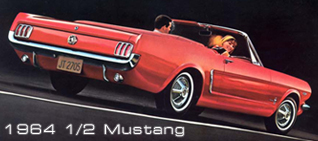
Mustang: the original pony car.
The Ford Mustang created and defined an entire class of automobile dubbed the “pony car”. These cars had certain characteristics such as long hood/short deck proportions, compact sporty styling, and a wide range of options at an affordable price. GM’s Camaro and Firebird models were also examples of pony cars which were created on the heels of the Mustang, along with other models including the Dodge Challenger and Plymouth Barracuda.
Ford designed the Mustang quickly and went from prototype to showroom in just 18 months. This was due to its design being based on the Ford Falcon’s platform and using many of the same parts. Ford debuted the Mustang at the World’s Fair in New York on April 17, 1964 with a major media campaign – one of the most successful product launches in history. The company projected sales of 100,000 units for the first year but passed that number in 3 months, with over 1 million sold in just 18 months.
The original Mustang had a 170hp 6 cylinder engine with a 3 speed automatic transmission. A 260hp V8 and 4 speed automatic were available. Body styles included a coupe or convertible available in 18 different colors and were very affordable with a base price of just $2,350. Several features added for the start of the traditional 1965 model year in August 1964 included backup lights, alternators (instead of generators), and a larger V8 engine (289 cubic inch) and, while Ford considers all of them to be 1965 models, the 121,000 early models are unofficially referred to as 1964 1/2 models.
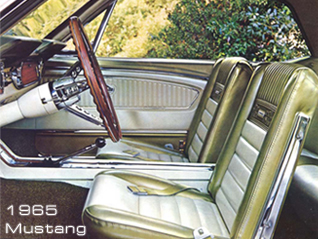

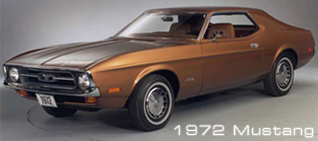
1st Generation
The 1965 – 1973 Mustangs shared the same platform (Ford Falcon) but with each passing year the slight design changes continued to add weight and size to the car. The first significant changes came in 1967 in order to better compete with Chevy’s new Camaro. The ’67 model offered a new 6.4L 390 cubic inch V8 producing an impressive 390hp. Other changes included a new grille design, concave tail lights, improved suspension and a new GT package with driving lights, stripes, and dual exhaust.
New side marker lights identified 1968 models along with windshield-mounted rearview mirrors that new federal regulations required. The standard V8 engine was now 302 cubic inches and one of the highly sought after performance options was the new 427 Cobra Jet which was built race-ready straight from the showroom.
Mustangs have always been highly customizable. In 1969, performance options included the Boss 302, Shelby GT350, GT500, and Mach 1 models.
1970-73 models saw few notable changes but the car continued to grow in length and weight. In fact, the 1971 was the longest Mustang ever. Available power from the engine offerings started to decline after 1970 in response to new emission control requirements and the 351 cubic inch V8 was the only V8 offered in 1972 and 73. Sales of Mustangs were also declining during this time because buyers wanted a more trim and nimble car, especially with the sharply rising cost of gas.
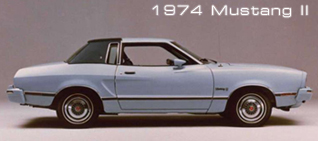
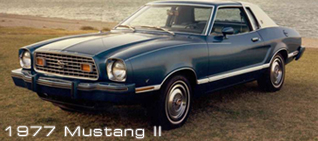
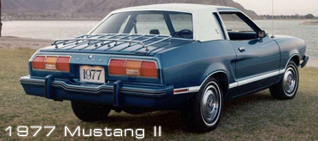
2nd Generation
In 1974, Ford introduced a completely new Mustang based on the subcompact Pinto platform which would remain with only minor changes through the 1978 model run, thus making this the 2nd generation. They also gave it a new name – Mustang II – in hopes of rekindling interest. With the rising cost and short supply of gas, the mid 1970s was just the right time for a more fuel efficient, smaller model of Ford’s original pony car. Even without any serious high performance options, buyers lined up and sales soared over the previous version. Over 385,000 were sold in just the first year.
The 2nd generation Mustangs were only available as a coupe or hatchback and the standard engine was a 140 cubic inch 4 cylinder producing only 88hp. The only optional engine in 1974 was a 105hp 2.8 litre V6. The 302 cubic inch V8 returned in 1976.
Many buyers in the mid 1970s wanted more luxury features, so Ford included such options as a padded vinyl roof cover and opera windows.
Many writers had mixed reviews, noting that these cars were slow with the standard engines and lacked true performance characteristics. Ford had lost the performance edge to GM’s Camaro & Firebird models. On the other hand, the Mustang II earned positive reviews for its styling and practical value considering the fuel crisis. Modern day reviews of the 2nd generation Mustangs have not been so kind, calling them underpowered, poor handling, and low quality.

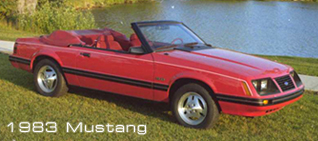
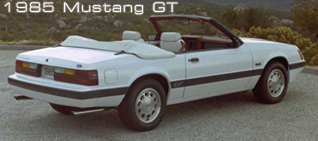
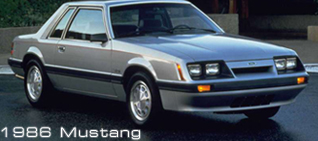
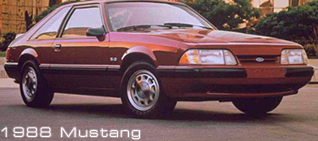
3rd Generation
The 3rd generation Mustang debuted in 1979 and was one of Ford’s Fox platform vehicles. This was the basic architecture for many Ford models of the 1980s & 90s including the Fairmont, Zephyr, Granada, Thunderbird, and more. The Fox Mustangs continued through the 1993 model year, with a restyling in 1987.
The 1979 Mustang was a vast improvement over the Mustang II in nearly every way, although the same engines carried over until 1982. It had a fresh, thoroughly modern style and did not carry over any of the design cues of previous models. Better suspension design and state of the art Michelin tires helped greatly improve the handling of these cars..
The performance revival began in 1982 with the return of the Mustang GT with its 5.0 V8, which topped the Camaro & Firebird for power and, given the Mustang’s weight being 400lb less, earned the Mustang the title of fastest car in America.
The convertible returned in the 1983 model year and looked great with the new body style.
In 1984, Ford created a version of the Mustang that it hoped would compete with the best performance cars from Germany. Called the Mustang SVO (from Ford’s new Special Vehicle Operations Dept.), this car was different from other Mustangs both visually and mechanically and was priced nearly $6,000 higher. It had a 2.3L turbocharged, fuel injected, intercooled 200hp 4 cylinder engine, extensively modified and improved suspension and brakes, and specific hood, bumper covers, side moldings, and rear spoiler. This model was only sold until 1986 and was a marketing failure. It was essentially just another Mustang and not unique enough to support the significantly higher price.
Mustang received a major facelift for 1987 with a more “aero” style, with Mustang GT getting its own unique look with a redesigned nose and lower body moldings. There were only two models offered: LX and GT in coupe and convertible form, and only the 2.3L 4 cylinder and 5.0L V8 engines. Driver’s side air bags were first seen in 1990. This model lineup proved quite popular and continued with only incremental changes through the 1993 model year.
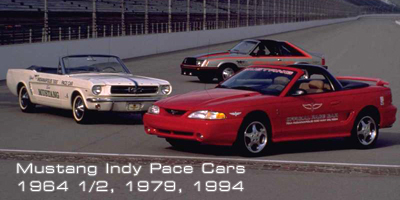
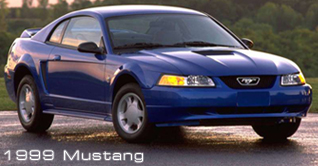
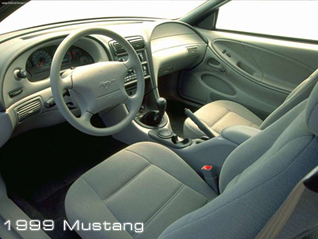
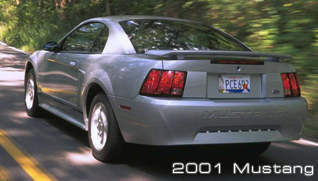
4th Generation
The 4th generation Mustang debuted in 1994 on a new platform derived from the Fox design and called SN-95. The exterior and interior featured a dramatic new style with throwbacks to the original pony car design; however, there would be no hatchback body style. A 3.8L V6 powered the base coupes while the 5.0L V8 powered the GT for 1994 and 1995. Ford introduced a new modular 4.6L V8 for the Mustang GT in 1996 which was standard through 2010. Transmission, suspension, and noise & vibration were also improved and earned Mustang Motor Trend’s Car of the Year award for 1994. The Mustang Cobra model also returned, redesigned with its own unique front fascia, a modified 5.0L V8 and suspension. The Mustang Cobra was once again the Indianapolis 500 Pace Car in 1994.
A facelift in 1999 gave the SN-95 Mustang Ford’s new “New Edge” styling theme featuring sharper contours, bodyside creases, and larger wheel arches, It was definitely an improvement over the previous softer styling. The car’s basic design remained the same so this is still a 4th generation SN-95, although some refer to it as SN-95.2. The engine options remained the same but each year brought improvements and more power. By 2004, the 3.8L V6 had improved to 190hp and the 5.0L V8 to 260hp, while the modified engine in the Cobra model turned out an impressive 390hp. Ford also introduced a couple of special editions of the Mustang GT: in 2001, the Bullitt (based on the 1968 model in the Steve McQueen film of the same name) and in 2003 the Mach 1 model, reminiscent of the 1969-70 models of the same name. There was also a 40th anniversary edition in 2004.
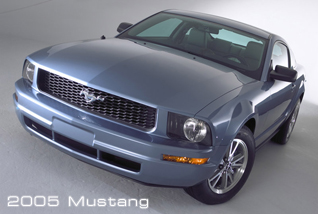
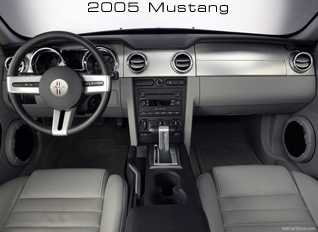

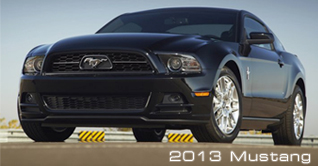
5th Generation
The 5th generation Mustang (2005 – 2014) rode on a brand new platform called S-197 that was not shared by any other models. There were improvements in nearly every area over the previous generation, including brakes, suspension, comfort, and quality. Passenger comfort got a boost too as the new body offered an increase of 6 inches in the wheelbase. The body styling combined elements of the 1969 Mustang fastback design with modern technology and has proven extremely popular. A new V6 engine debuted with this model – the 4.0L single overhead cam V6 putting out 210hp, and for the first time a 5-speed automatic transmission was available. A new option debuted in 2006 for V6 models: the Pony Package. This offered the look of the Mustang GT model on the base model and included a GT-inspired grill with foglamps, GT wheels & instrument gauges, body stripes, and special logos inside.
The next minor design change came in 2010 with small updates to the interior and exterior styling and suspension. In 2011 a new 3.7L “Duratec 37” V6 engine debuted with power greatly increased to over 300hp along with new 6-speed automatic or manual transmissions. The 5.0L V8 in the 2013 GT put out 412hp. These were definitely the most powerful Mustangs ever! A couple of super high performance models also returned, including the Boss 302 and Shelby GT500 with a 662hp supercharged engine.
6th Generation
